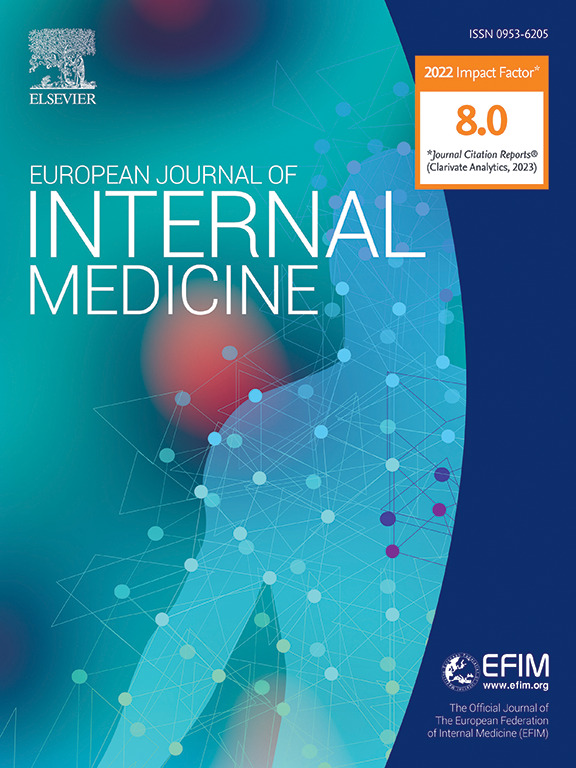Hypochloremia in chronic and acute heart failure scenarios: Prevalence and risk factors
IF 6.1
2区 医学
Q1 MEDICINE, GENERAL & INTERNAL
引用次数: 0
Abstract
Aims
Chloride plays a key role in maintaining volume homeostasis. Low plasmatic chloride levels are associated with diuretic resistance and worse outcomes in patients with heart failure (HF). This study focused on determining the prevalence and factors related to hypochloremia in patients with heart failure (HF) in chronic and acute settings.
Methods
We conducted a retrospective analysis of three cohorts: chronic HF patients from the Spanish Cardiorenal Registry, ambulatory patients with worsening heart failure (WHF) from the SALT-HF trial, and inpatient WHF admitted in a teaching-level center in Spain. Multivariate linear regression analyses were employed to identify factors associated with chloremia.
Results
The chronic HF cohort included 845 patients [median age 75 years, 38 % female, 62.7 % presenting with a left ventricular ejection fraction (LVEF)≤40 %]. The prevalence of hypochloremia was 5.5 %. The second cohort (ambulatory WHF) comprised 148 participants (median age 80 years, 30 % female, 50 % displaying LVEF ≥ 50 %). Here, hypochloremia was observed in 11 % of the sample. The third cohort (inpatient WHF) enrolled 427 patients (median age 87 years, 64 % female, 82 % with LVEF≥50 %). This group showed a hypochloremia prevalence of 24 %. Multivariate analysis identified lower plasma sodium, loop diuretic treatment, and higher CA125 as common factors independently related to lower chloride levels in the three cohorts.
Conclusions
Prevalence of hypochloremia in HF differ across clinical status. Lower chloride is associated with lower sodium levels, prior loop diuretic and thiazide treatment, and higher CA125 values.

慢性和急性心力衰竭的低氯血症:患病率和危险因素。
目的:氯离子在维持体积平衡中起关键作用。低血浆氯化物水平与利尿剂抵抗和心衰(HF)患者预后不良相关。本研究的重点是确定慢性和急性心力衰竭(HF)患者低氯血症的患病率和相关因素。方法:我们对三个队列进行了回顾性分析:来自西班牙心脏肾脏登记处的慢性心力衰竭患者,来自SALT-HF试验的恶化心力衰竭(WHF)的门诊患者,以及西班牙教学级中心收治的住院WHF患者。采用多元线性回归分析确定与氯血症相关的因素。结果:慢性HF队列包括845例患者[中位年龄75岁,38%为女性,62.7%表现为左心室射血分数(LVEF)≤40%]。低氯血症的患病率为5.5%。第二个队列(流动WHF)包括148名参与者(中位年龄80岁,30%为女性,50%为LVEF≥50%)。在这里,在11%的样本中观察到低氯血症。第三队列(住院WHF)纳入427例患者(中位年龄87岁,64%为女性,82%为LVEF≥50%)。该组低氯血症患病率为24%。多因素分析发现,在三个队列中,较低的血浆钠、环状利尿剂治疗和较高的CA125是与较低的氯水平独立相关的共同因素。结论:HF患者低氯血症的患病率因临床状况而异。较低的氯与较低的钠水平、先前的利尿剂和噻嗪类药物治疗以及较高的CA125值有关。
本文章由计算机程序翻译,如有差异,请以英文原文为准。
求助全文
约1分钟内获得全文
求助全文
来源期刊
CiteScore
9.60
自引率
6.20%
发文量
364
审稿时长
20 days
期刊介绍:
The European Journal of Internal Medicine serves as the official journal of the European Federation of Internal Medicine and is the primary scientific reference for European academic and non-academic internists. It is dedicated to advancing science and practice in internal medicine across Europe. The journal publishes original articles, editorials, reviews, internal medicine flashcards, and other relevant information in the field. Both translational medicine and clinical studies are emphasized. EJIM aspires to be a leading platform for excellent clinical studies, with a focus on enhancing the quality of healthcare in European hospitals.

 求助内容:
求助内容: 应助结果提醒方式:
应助结果提醒方式:


